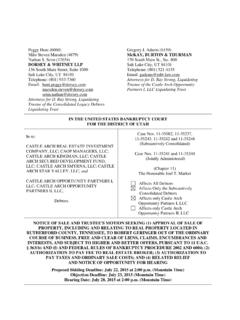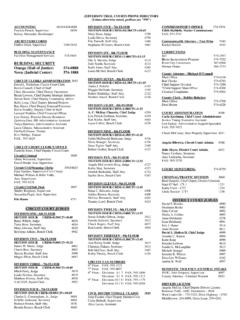Transcription of Historical overview Dec06.
1 Historical overview The Australian Industrial Relations Commission Inquiries 1300 799 675 Web Historical overview Contents The 1890s and Federation ..2. First 50 years 1904-56: from establishment of the Arbitration Court to the Boilermakers' case ..3. Arbitration Commission Australian Industrial Relations Industrial Relations Reform Act Workplace Relations Act 1996 ..8. Referral of Victorian industrial relations powers to the Work Choices Act 2005 9. This booklet sketches the Historical background to the Australian Industrial Relations Commission. The 1890s and Federation The establishment of special tribunals in Australia for industrial relations purposes had its origins in the major strikes of the 1890s. These bitter struggles between capital and organised labour caused widespread dislocation and distress.
2 The damage done to the social and economic fabric of colonial society led to a growing community belief that, if employers and unions could not resolve their disputes, then they should be required in the public interest to submit their competing claims to an independent third party for arbitration: a new province for law and order' should replace what had become the law of the jungle. By the end of the first decade of the 20th century all States (previously colonies) of the recently-formed federal Commonwealth of Australia and the Commonwealth itself had established industrial tribunals. Another development during the 1890s was the Australian colonies' move towards political federation. Arrangements for a federal Commonwealth of Australia were developed in a series of conventions which drafted a Constitution (or body of fundamental principles according to which a country is governed) for the proposed federation.
3 As part of this process the main industrial relations power of the Issued Dec 06 Page 2 of 9. Historical overview Commonwealth was written into the Constitution as section 51, placitum xxxv, namely that the Commonwealth Parliament has power to make laws with respect to conciliation and arbitration for the prevention and settlement of industrial disputes extending beyond the limits of any one State'. Federation was achieved when the Commonwealth of Australia came into existence on 1 January 1901. First 50 years 1904-56: from establishment of the Arbitration Court to the Boilermakers' case The first federal industrial tribunal - the Commonwealth Court of Conciliation and Arbitration - was established under the Conciliation and Arbitration Act passed by the Federal Parliament in 1904.
4 The Court which initially consisted of a High Court judge had both arbitral and judicial powers; that is it could make an award specifying wages and conditions of employment in settlement of an interstate dispute and it could interpret and enforce the award, if necessary imposing penalties on any party to the award who did not comply with its provisions. The Act also provided for the registration of organisations of employers and employees (unions). The federal system had a slow beginning - the Court made only six awards in its first five years and in 1910 Higgins J, the President of the Court at the time, noted that the approach to the Court was through a bog of technicalities'. Higgins J is perhaps best remembered as the author of the famous Harvester judgment in 1907 [Ex parte HV.]
5 McKay (Harvester Case) (1907) 2 CAR 1] which established the concept of the basic or foundational wage, a component of federal award wages for 60 years. The Bruce Government was defeated over its attempt to withdraw the Commonwealth from industrial relations regulation (excluding the maritime industry) in favour of the States in the late 1920s. By this time, the federal tribunal had increased its influence rapidly relative to the influence of state tribunals. The Court was completely reconstituted in 1926 to comprise a Chief Judge and other judges and the legislation then contained: explicit reference to the basic wage and provision that cases relating to it, together with those concerning hours of work, be heard by a multi-member or Full Bench.
6 Provision for the Commonwealth Attorney-General to intervene in the public interest' in basic wage and hours cases - this facilitated the Federal Government putting submissions to the Court; and provision for the appointment of Conciliation Commissioners to assist parties to reach agreements - at first only one was appointed and his term came to an end in 1934, but ten had been appointed by the end of 1944. Issued Dec 06 Page 3 of 9. Historical overview The Conciliation and Arbitration Act 1904 was amended in 1947 to enhance the role of Conciliation Commissioners, and to separate the roles of the Court and the commissioners. The Court was confined to judicial functions (interpretation and enforcement) and arbitration in respect of four specified matters, namely basic wage, minimum female wage, hours of work and paid annual leave.
7 All other matters were left for Conciliation Commissioners. This separation led to concern about consistency of approach and amendments to the Act in 1952 sought to enhance co-ordination between judges and commissioners. Arbitration Commission 1956-1988. The conciliation and arbitration machinery underwent a fundamental change in 1956. following the decision of the High Court in the Boilermakers' case [R v. Kirby and others; ex parte the Boilermakers' Society of Australia (1955-56) 94 CLR 254]. The High Court held that it was unconstitutional for the Commonwealth Court of Conciliation and Arbitration to be vested with both arbitral and judicial powers because of the acceptance in the Constitution of the separation of legislative and judicial powers.
8 As a result, the Conciliation and Arbitration Act 1904 was amended to establish two separate bodies: the Commonwealth Conciliation and Arbitration Commission (renamed the Australian Conciliation and Arbitration Commission in 1973) to exercise the conciliation and arbitration power; and the Commonwealth Industrial Court (which in 1977 became the Industrial Division of the Federal Court) to exercise judicial power. Most of the members of the old Court were appointed to the Arbitration Commission. The Commission consisted of a President, Deputy Presidents, a Senior Commissioner, Commissioners and (non-member) Conciliators. The presidential members had to be either judges of the old Court or lawyers of five years' standing. No formal qualifications were required for commissioners and conciliators.
9 It was envisaged that day-to-day work within the Commission would be the function of commissioners and conciliators, leaving the presidential members to deal with matters of larger importance. The President allocated industries or disputes to members. Full Benches were of three kinds: the Commission in presidential sessions (at least three such members) to determine the basic wages of both males and females, hours of work and paid long service leave;. matters referred in the public interest' to be heard by a bench of mixed (presidential and non-presidential) composition; and appeal benches, again of mixed composition. Issued Dec 06 Page 4 of 9. Historical overview Some of the flavour of the change in arbitration proceedings after 1956 is conveyed in the following comments made by the inaugural President of the Commission, Sir Richard Kirby, as part of a review of the Commission's first decade of operation: For the first time Judges and lay Commissioners became jointly members of a Commonwealth arbitration tribunal often sitting together as members of full benches and each helping the other with their different types of training and experience.
10 Another change associated with the setting up of a Commission in preference to a Court lies in the more relaxed and less formal conduct of proceedings before single members and full benches which is to some extent symbolised by the discarding early in the Commission's history of wigs and gowns by Judges and members of the legal profession.'. [President's Tenth Annual Report to Parliament for the year ended 13 August 1966]. This booklet has noted the 1907 Harvester judgment and made reference to basic wages. The Harvester judgment was the first attempt at establishing a wage based upon needs, below which no worker should be expected to live. In that case Higgins J. said that a fair and reasonable wage' for an unskilled labourer would be based on the normal needs of the average employee, regarded as a human being living in a civilized community' [at ].




